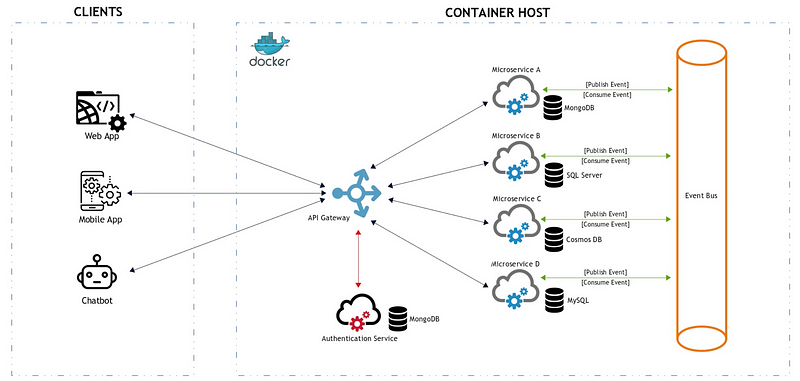In the era of cloud computing and distributed systems, microservices architecture has emerged as a powerful approach to building scalable, maintainable, and resilient backend systems. Unlike monolithic architectures, where all components are tightly coupled, microservices break down applications into smaller, independent services that can be developed, deployed, and scaled independently.
However, designing microservices for scalability is not a trivial task. It requires careful planning, adherence to best practices, and a deep understanding of the principles of distributed systems. In this blog, we’ll explore how to design microservices for scalable backend systems, covering key concepts, best practices, and practical tips.
What Are Microservices?
Microservices are an architectural style where an application is composed of small, loosely coupled, and independently deployable services. Each service is responsible for a specific business capability and communicates with other services through well-defined APIs.
Key Characteristics of Microservices:
- Decentralized: Each service operates independently and has its own database, logic, and dependencies.
- Scalable: Services can be scaled independently based on demand.
- Resilient: Failures in one service do not cascade to others.
- Technology-Agnostic: Services can be built using different programming languages, frameworks, and databases.
- Automated: CI/CD pipelines enable rapid deployment and updates.
Why Use Microservices for Scalability?
Microservices offer several advantages for building scalable backend systems:
- Independent Scaling: Each service can be scaled horizontally based on its workload, optimizing resource usage.
- Fault Isolation: Failures in one service do not affect the entire system, improving resilience.
- Flexibility: Teams can choose the best tools and technologies for each service.
- Faster Development: Smaller, focused teams can develop and deploy services independently.
- Improved Performance: Services can be optimized for specific tasks, reducing latency and improving throughput.
Key Principles for Designing Scalable Microservices
To design microservices that can scale effectively, follow these principles:
1. Single Responsibility Principle (SRP)
Each microservice should have a single responsibility or business capability. This ensures that services remain small, focused, and easy to scale.
- Example: In an e-commerce system, separate services for
Order Management,Inventory Management, andPayment Processing.
2. Decentralized Data Management
Each microservice should have its own database or data store. This avoids tight coupling and allows services to scale independently.
- Example: The
User Servicemanages user data, while theProduct Servicemanages product data.
3. API-First Design
Design APIs carefully to ensure clear communication between services. Use REST, GraphQL, or gRPC for inter-service communication.
- Example: Use RESTful APIs with JSON payloads for simplicity and compatibility.
4. Asynchronous Communication
Use asynchronous communication (e.g., message queues or event streams) to decouple services and improve scalability.
- Example: Use Apache Kafka or RabbitMQ for event-driven communication.
5. Stateless Services
Design services to be stateless, storing session data externally (e.g., in a database or cache). This makes it easier to scale horizontally.
- Example: Use Redis or Memcached for session storage.
6. Resilience and Fault Tolerance
Implement retries, circuit breakers, and fallback mechanisms to handle failures gracefully.
- Example: Use tools like Hystrix or Resilience4j for fault tolerance.
7. Automated CI/CD Pipelines
Automate testing, deployment, and scaling to ensure rapid and reliable updates.
- Example: Use Jenkins, GitLab CI, or GitHub Actions for CI/CD.
Steps to Design Scalable Microservices
Step 1: Identify Business Capabilities
Break down your application into distinct business capabilities. Each capability will become a microservice.
- Example: For an e-commerce platform, capabilities might include
User Management,Product Catalog,Order Processing, andPayment Gateway.
Step 2: Define Service Boundaries
Clearly define the boundaries of each microservice to avoid overlap and ensure loose coupling.
- Example: The
Order Serviceshould handle order creation and tracking, while thePayment Serviceshould handle payment processing.
Step 3: Choose the Right Communication Patterns
Decide how services will communicate with each other. Use synchronous communication (e.g., REST, gRPC) for real-time interactions and asynchronous communication (e.g., message queues, event streams) for decoupled workflows.
- Example: Use REST for fetching product details and Kafka for order notifications.
Step 4: Design Scalable Data Storage
Choose the right database for each service based on its requirements. Use relational databases for structured data and NoSQL databases for unstructured or high-volume data.
- Example: Use PostgreSQL for the
User Serviceand MongoDB for theProduct Service.
Step 5: Implement API Gateways
Use an API gateway to manage external requests, route traffic, and handle cross-cutting concerns like authentication and rate limiting.
- Example: Use Kong, NGINX, or AWS API Gateway.
Step 6: Monitor and Optimize
Implement monitoring and logging to track performance, detect bottlenecks, and optimize resource usage.
- Example: Use Prometheus for monitoring and ELK Stack (Elasticsearch, Logstash, Kibana) for logging.
Best Practices for Scalable Microservices
- Use Containers and Orchestration: Deploy microservices in containers (e.g., Docker) and use orchestration tools (e.g., Kubernetes) to manage scaling and deployment.
- Leverage Caching: Use caching to reduce database load and improve response times. Tools like Redis or Memcached are ideal for this purpose.
- Implement Auto-Scaling: Use cloud-native auto-scaling features (e.g., AWS Auto Scaling, Kubernetes Horizontal Pod Autoscaler) to handle traffic spikes.
- Secure Your Services: Implement authentication, authorization, and encryption to protect your services.
- Test Thoroughly: Use unit tests, integration tests, and load tests to ensure reliability and performance.
Real-World Example: Netflix
Netflix is a prime example of a scalable microservices architecture. The platform is built on hundreds of microservices that handle everything from user authentication to video streaming. By using microservices, Netflix can:
- Scale individual components (e.g., recommendation engine) independently.
- Deploy updates without disrupting the entire system.
- Handle millions of concurrent users with low latency.
Tools and Technologies for Microservices
| Category | Tools |
|---|---|
| API Gateway | Kong, NGINX, AWS API Gateway |
| Service Discovery | Consul, Eureka, Zookeeper |
| Communication | REST, gRPC, Apache Kafka, RabbitMQ |
| Containerization | Docker, Podman |
| Orchestration | Kubernetes, Docker Swarm |
| Monitoring | Prometheus, Grafana, ELK Stack |
| CI/CD | Jenkins, GitLab CI, GitHub Actions |
Conclusion
Designing microservices for scalable backend systems is a challenging but rewarding endeavor. By following the principles and best practices outlined in this blog, you can build a system that is flexible, resilient, and capable of handling growing demands. Remember to start small, iterate often, and continuously monitor and optimize your architecture.

